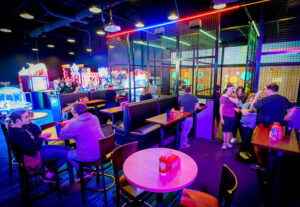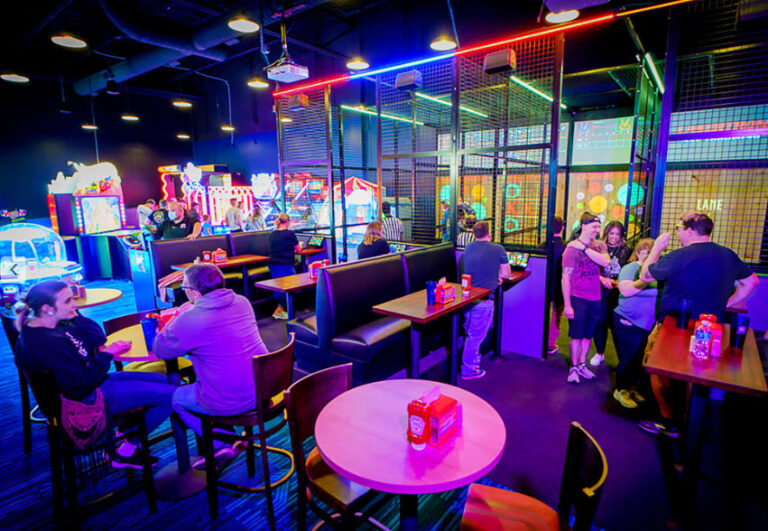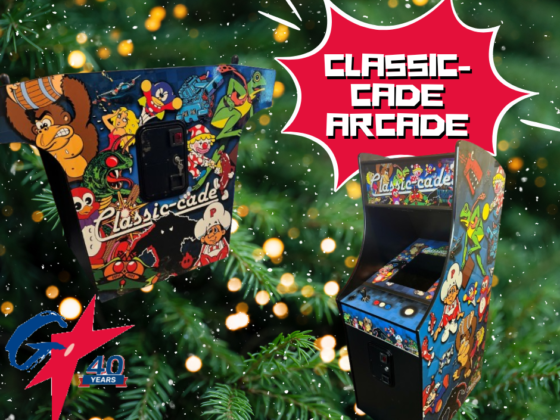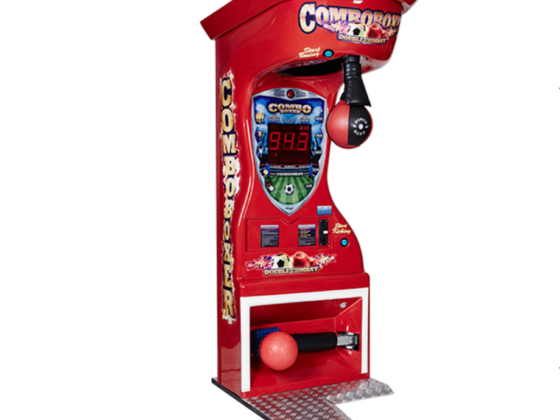Arcade Game Room Design Basics

Are you looking to create your business’s ultimate arcade game room experience? If so, there are a few essential elements to remember when designing your space. This article will cover critical factors in organizing a game room, such as the necessary square footage and game types. Arcades games and prizes, done well, will add significant incremental revenue and an experience that will drive return visits.
Square Footage & Cost
Firstly, consider the size of your space and how many games you want to include. A moderate game room of 1,500 to 2,000 square feet can typically fit 20 to 30 games, costing the proprietor or supplier $250,000 to $350,000. It’s worth noting that the industry has seen incredible growth in recent years, and manufacturers are now offering larger-scale attraction pieces, which have increased the average cost per game and square footage requirements.
Key Figures*
- Average Per Game Budget: $12,000-$15,000
- Average Per Game Revenue: $250/Week
- Average Per Game Space Allocation: 65 Square Feet
Layout & Sightlines
When designing the entrance to your arcade space, it’s crucial to create a welcoming and comfortable environment that draws people in. Consider using glass doors or wide entrances with plenty of windows to encourage visitors to come inside while still feeling cozy and comfortable. We typically place “see-through” or low games at the entrance to create an exciting atmosphere, while high-activity simulators or virtual reality games can generate a buzz.
Unattended virtual reality (VR) attractions have become increasingly popular in recent years, offering customers an immersive experience without staff supervision. These attractions often involve high-tech equipment such as VR headsets, controllers, and other interactive devices that allow customers to explore virtual environments and engage in various activities.
To mitigate risks, it is essential to have unattended VR attractions near employees who can maintain the equipment and ensure it functions properly. This can involve regular checks of the equipment and prompt response to any issues or malfunctions that may arise. By having employees nearby, customers can be assured that the equipment is well-maintained and reliable, leading to a more enjoyable and satisfying experience overall.
When it comes to the layout of your arcade game room, think about grouping similar games to make it easier for customers to find what they’re looking for. Place specialty games in a safe but visible area in the back of the arcade to draw traffic in. Use sporting and alley games against side or back walls to encourage customer flow and highlight games near each other.
Plan a bank of Pinball games. There are amazing games that attract all ages. And with code updates and interactive apps from the pinball manufacturers, they just need power and internet to keep attracting players.
Crane games can also bring people back in with prizes such as gift cards and free play. Keeping Crane games stocked with colorful and highly desired merchandise can help this equipment producing profit.
Solid wall space is crucial, especially for new games such as ball, carnival, and sports-themed ones continuously being introduced into the market. These games are most effective when played against a sturdy wall. Placing them in the center of a room can obstruct sightlines and create barriers, which can be a hindrance. Also, loose balls can be a concern if they roll away in the middle of the arcade.
Grouping Games
 When it comes to the types of games to include in your arcade game room, consider a mix of video, premium video, and activity/sports games. Video games for gameplay and high scores, shooting, driving, air hockey, and pinball are other popular choices. Premium video games like King Kong of Skull Island VR and Asphalt 9 are also great options, as are activity and sports games such as Connect 4 Hoops, Rock the Rim, and Baseball Pro.
When it comes to the types of games to include in your arcade game room, consider a mix of video, premium video, and activity/sports games. Video games for gameplay and high scores, shooting, driving, air hockey, and pinball are other popular choices. Premium video games like King Kong of Skull Island VR and Asphalt 9 are also great options, as are activity and sports games such as Connect 4 Hoops, Rock the Rim, and Baseball Pro.
Finally, remember the importance of refreshing your game room regularly. Refreshing 10% to 20% of your room each year, evaluating the health of your game room, checking the age of the games, and moving your room around at least once a year can help keep your arcade game room engaging and exciting for your customers.
Arcade layout and design should not be approached with a one-size-fits-all mentality. While incorporating these tips can enhance the guest experience, working with the customer’s vision and the architect’s design is crucial to create a unique space. GAD has helped design thousands of commercial game rooms for arcades, hotels and business’. And, GAD is an authorized dealer for the best in class manufacturers of games of all kinds. Start by contacting our GAD sales team near you.




